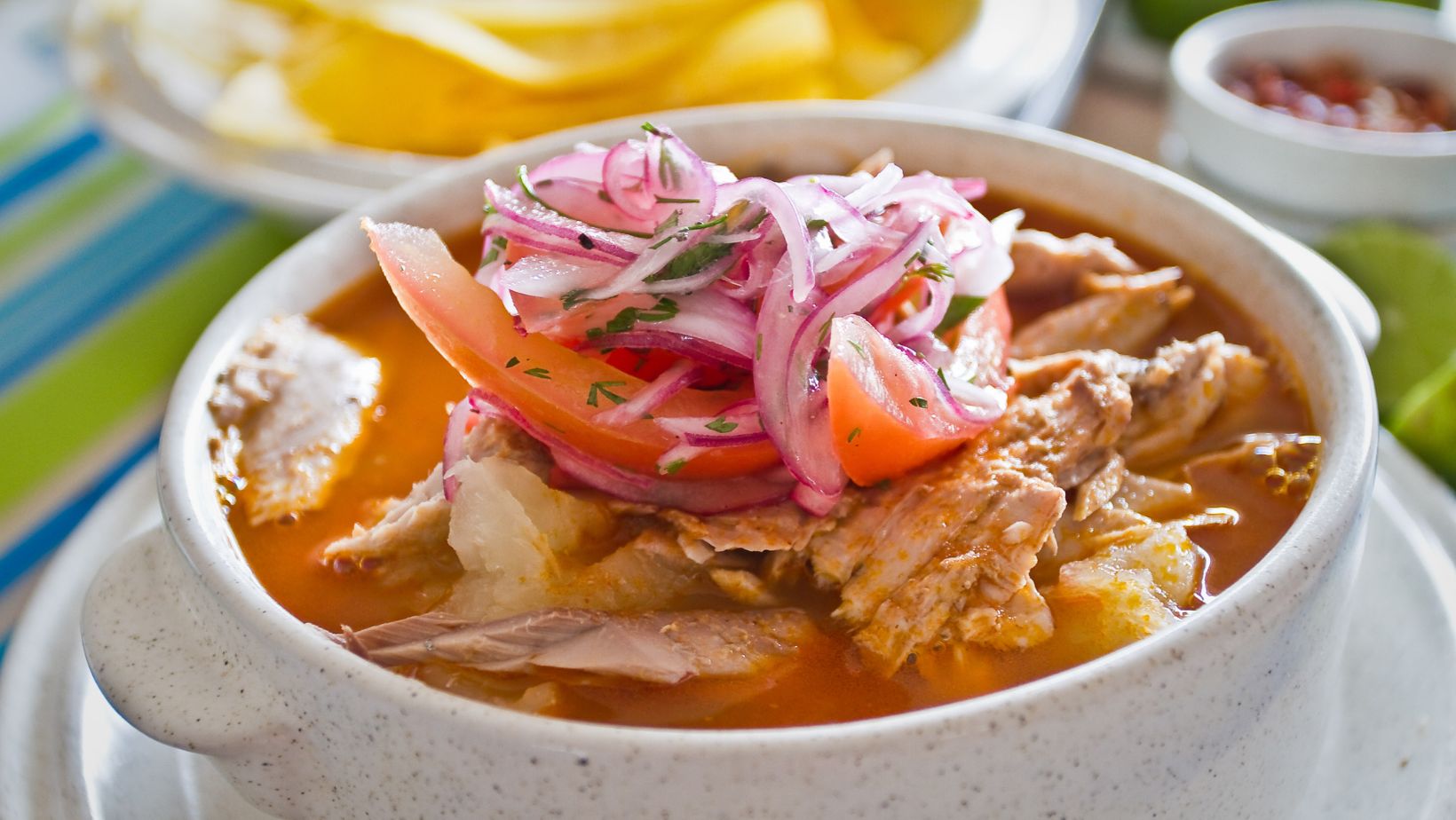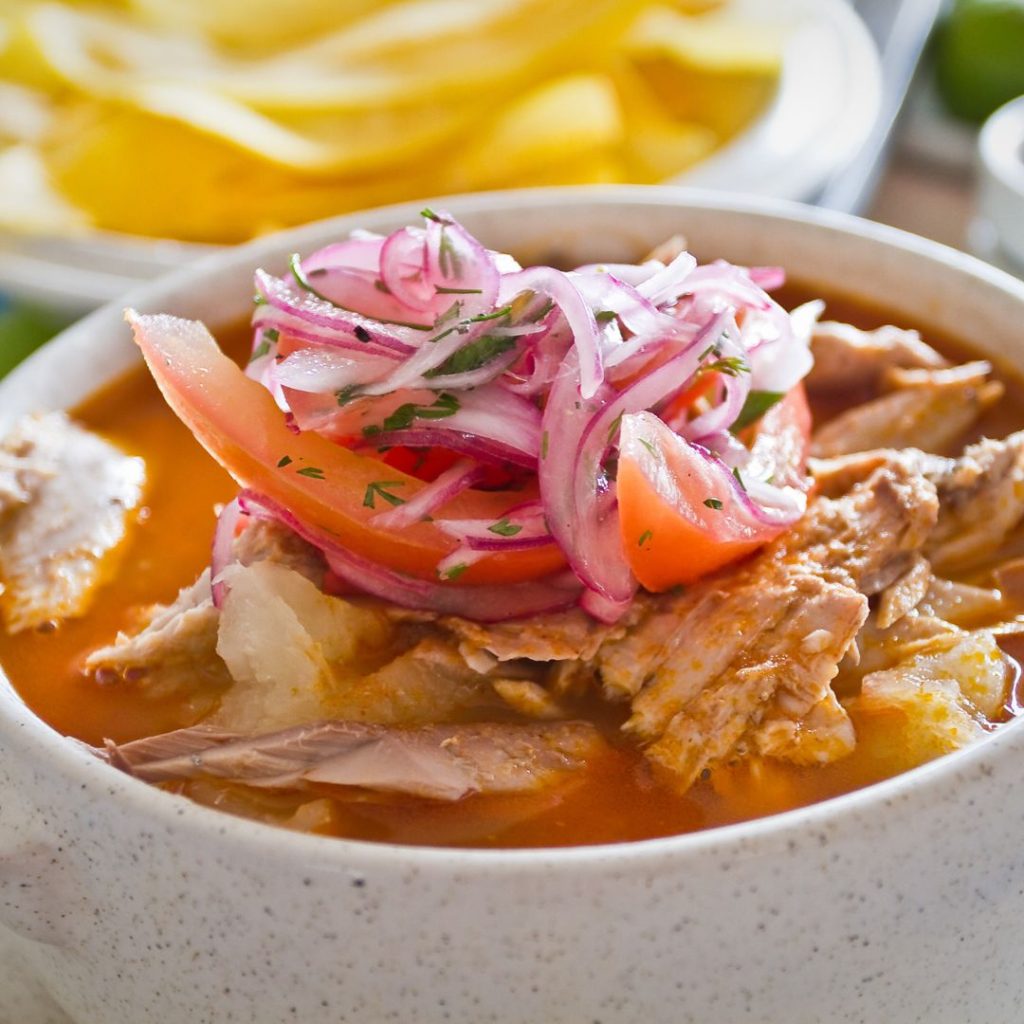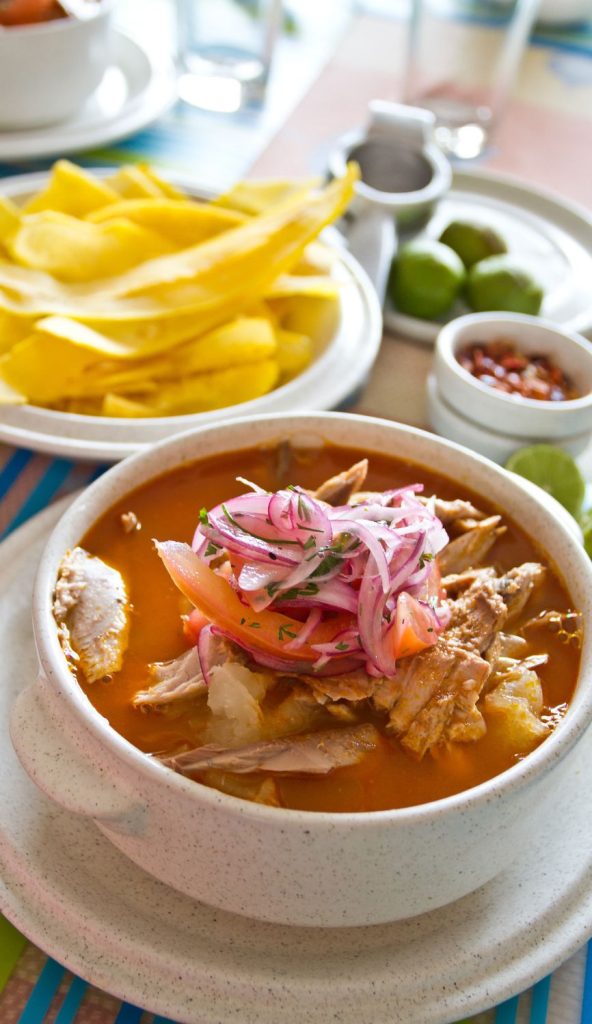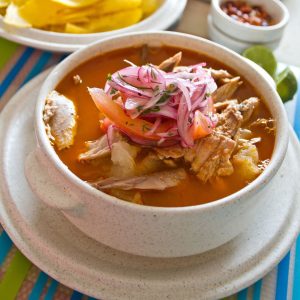Ecuadorian Fish Soup (Encebollado de Pescado)

This homemade Ecuadorian Fish Soup or as the locals call it, Encebollado de Pescado features fresh fish, cassava, and a blend of Latin spices, resulting in a comforting, soul-warming bowl of goodness. Join me in rediscovering this classic Ecuadorian recipe
Traditional Encebollado de Pescado
Hey friends! Prepare to savor the flavors of Ecuador with this traditional Encebollado de Pescado recipe, a cherished Ecuadorian fish soup that’s not just a dish but a piece of my heritage. Growing up in Cuenca, Ecuador, I fell in love with the simplicity and heartiness of this soup made by my grandmother, this dish truly captures the essence of my childhood that’s pure comfort food. 😋🍲
This traditional Ecuadorian soup, is a beloved staple in Ecuadorian cuisine. It’s a hearty and comforting dish that brings together the freshest seafood with the bold flavors of Latin spices. The star of the show is the albacore tuna, known locally as “pescado ecuatoriano,” which adds a rich and savory depth to the soup.
Now, I’ve traded the Andean hills for the cityscape of Toronto, Canada, but the flavors of home are always close to my heart. And today, I’m bringing a taste of Ecuador straight to your kitchen!
Join me on this food adventure as we whip up an authentic and homemade Encebollado de Pescado that’s easy to make, bursting with Latin spices, and simply delicious. Let’s dive in and make some food memories together! 🥄

What Is Encebollado de Pecado?
Encebollado de Pecado, a cherished part of my food memories from growing up in Cuenca, Ecuador, takes me back to days by the coast, enjoying the freshest seafood. But what exactly is Pecado de Encebollado, and why is it so special? Imagine a steaming bowl filled with tender chunks of fresh albacore fish, yuca (cassava) adding a hearty touch, and a sea of zesty lime-pickled onions and tomato. It’s a symphony of flavors, a true Ecuadorian delight.
Now, let’s talk about its roots. Encebollado fish soup has deep origins in the coastal regions of Ecuador, particularly in places like Guayaquil and Manabí. It’s a dish that showcases our food heritage, blending indigenous ingredients with Spanish, African, and Asian influences.
The name ‘Encebollado de Pescado’ translates to ‘Fish Cooked with Onions’ in Spanish, and you’ll soon understand why. Onions play a starring role in this dish, imparting layers of savory goodness.
However, the heart of encebollado lies in the fish. Fresh, succulent, often albacore or tuna, it pays homage to coastal communities where fishing is a way of life. The abundance of seafood inspired a dish that transforms the day’s catch into a hearty celebration. As time passed, encebollado adapted, with each region in Ecuador adding its unique touch. But the core components remain constant: fish, yuca, and, of course, plenty of onions. A dash of cumin and other spices gives it that distinct flavor.
So, when you savor a bowl of this Ecuadorian Fish Soup , you’re not just enjoying a soup – you’re savoring Ecuador’s history and food heritage.

Why You Will Love This Traditional Ecuadorian Fish Soup
Here why you love this Ecuadorian Fish Soup, or as we fondly call it, Encebollado de Pescado, it’s an absolute must-try. 🍲💖
- A Taste of Tradition: Encebollado de Pescado is a beloved Ecuadorian classic that’s been passed down through generations, making it a taste of tradition and nostalgia.
- Fresh and Flavorful: This soup is all about fresh, authentic flavors. With tender fish, hearty yuca, and zesty lime-pickled onions, every spoonful bursts with delicious tastes and textures.
- Latin Spice: Dive into a world of Latin spices and aromas. Encebollado is delicately seasoned with cumin and other spices, adding a delightful layer of flavor that’ll keep you coming back for more.
- A Seafood Lover’s Dream: If you’re a seafood enthusiast, this soup is a dream come true. Fresh fish takes center stage, and its delicate, succulent flavor is perfectly complemented by the other encebollado ingredients. 🐟🦐
- A Touch of Cuenca: For me, this Encebollado recipe is a taste of home in Cuenca, Ecuador. It’s where I first fell in love with this soup, and I’m thrilled to share it with you, bringing a piece of my Ecuadorian heritage to your table.
Ingredients For Ecuadorian Fish Soup
I personally chose each ingredient for this Encebollado de pescado recipe to capture the authentic flavors of Ecuador. Let me walk you through the key components: Note the complete list of ingredients and measurements are in the recipe card below.
- Fresh Albacore Tuna (Pescado Ecuatoriano): The star of this dish is fresh albacore tuna, known as “pescado ecuatoriano” in Ecuador. Its tender, flaky texture and mild flavor make it perfect for this soup.
- Yuca (Cassava): Yuca, or cassava, adds a hearty element to the soup. It’s a staple in Ecuadorian cuisine, providing a satisfying texture and a touch of sweetness.
- Lime Pickled Onions and Tomato: These tangy, zesty onions and tomatoes are a quintessential element of Encebollado. They bring a burst of flavor and brightness to each spoonful.
- Tomatoes and Bell Peppers: Diced tomatoes, red bell peppers, and green bell peppers contribute to the soup’s vibrant color and provide a subtle sweetness.
- Aromatic Spices: Ground cumin and paprika infuse the soup with warm, earthy notes, enhancing its depth of flavor.
- Garlic: Minced garlic adds a savory aroma and a hint of spice to the broth.
- Fish or Seafood Broth: A flavorful fish or seafood broth forms the base of the soup, enriching it with the essence of the sea.
- Vegetable Oil: Vegetable oil is used for sautéing the aromatics and adding a touch of richness to the soup.
- Salt and Pepper: These simple yet essential seasonings bring out the best in all the ingredients, harmonizing the flavors.
- Lime Wedges, Sliced Tomato, Cilantro, and Hot Sauce: These optional garnishes allow you to customize your Encebollado to your taste, adding extra zest, freshness, and heat.

Tips To Make Best Ecuadorian Fish Encebollado Soup
Get ready to take your Ecuadorian Fish Soup to the next level with these helpful tips. Your taste buds are in for a treat! 😍
- Start with Fresh Fish: Look for the freshest albacore tuna you can find. Fresh seafood makes all the difference.
- Don’t Rush the Broth: Allow the broth to simmer and meld the flavors. Patience is key.
- Tapioca Time: Yuca, also known as tapioca or cassava, should be tender but not mushy. Be mindful of cooking time.
- Taste as You Go: While simmering the soup, taste it periodically and adjust the seasoning as needed. Customize the level of spice to your liking. Add more cumin for extra flavor. Remember, it’s all about achieving that perfect balance of flavors.
- Lime Pickled Onions: The lime-pickled onions are a must; they provide a zesty contrast to the rich broth.
- Taste as You Go: While simmering the soup, taste it periodically and adjust the seasoning as needed. Remember, it’s all about achieving that perfect balance of flavors.
- Pair with Sides: This fish soup pairs wonderfully with sides like avocado slices, plantain chips, or a simple side salad for a complete meal.
- Serve Hot: Pecado de Encebollado is best enjoyed hot. Serve it immediately to enjoy the full flavors and textures.
How To Make Ecuadorian Fish Soup (Encebollado de Pescado)
- Prepare the Lime Pickled Onions: In a small bowl, combine the thinly sliced red onion and tomato wedges with the juice of 2 limes. Let it sit for about 15 minutes to marinate. Set aside.
- Cook the Yuca (Cassava): In a large pot, bring the 2 cups of water to a boil. Add the yuca (cassava) chunks and cook until tender but not mushy, about 10-15 minutes. Drain and set aside.
- Sauté the Aromatics: In a large soup pot, heat the vegetable oil over medium heat. Add the minced garlic and sauté for about 1 minute until fragrant. Add the diced tomatoes, red and green bell peppers, ground cumin, and paprika. Sauté for another 5 minutes until the vegetables start to soften.
- Add the Broth: Pour in the fish or seafood broth and bring the mixture to a simmer.
- Cook the Tuna: Gently add the fresh albacore tuna (pescado ecuatoriano) to the simmering broth. Let it cook for about 10-15 minutes until the fish is cooked through.
- Incorporate Yuca and Season: Add the cooked yuca (cassava) chunks to the soup. Season with salt and pepper to taste.
- Serve and Garnish: Ladle the hot Encebollado de pescado into bowls. Top each bowl with some with a generous portion of lime-pickled tomato and onions. Garnish with fresh cilantro leaves. Serve with lime wedges, plantain chips, and hot sauce on the side for those who want an extra kick. 🍲🌶️🌿
More “Must Try” Tradtional Ecuadorian Recipes 🙌
Frequently Asked Questions
The best fish for this recipe is fresh albacore tuna. It provides a rich and succulent flavor to the soup. Albacore tuna is a popular choice in coastal Ecuador due to its availability and taste. The freshness of the fish is key to achieving the authentic taste of Encebollado, as it contributes to the delicate and tender texture of the fish chunks in the soup.
While fresh fish is recommended for the best flavor, you can use frozen albacore tuna if fresh isn’t available. Just make sure to thaw it before cooking. When using frozen fish, it’s important to thaw it properly in the refrigerator to preserve the texture and flavor. Allow the fish to thaw slowly in the fridge for several hours or overnight before incorporating it into the recipe.
Besides lime-pickled onions and cilantro, you can garnish your Encebollado with avocado slices, diced red onions, or even a sprinkle of toasted corn nuts for extra texture. The toppings are an opportunity to add a personal touch to your Encebollado. Avocado slices add creaminess, diced red onions offer extra zing, and toasted corn nuts provide a delightful crunch, creating a dynamic and flavorful bowl of soup.
Cassava is traditional, but if you can’t find it, you can use yams or sweet potatoes as a substitute. While cassava (yuca) provides a distinct texture and flavor to Encebollado, yams or sweet potatoes can be used as alternatives. They offer a similar starchy element to the dish and can complement the flavors of the soup. Adjust the cooking time accordingly to ensure the root vegetables are tender but not mushy.

Ecuadorian Fish Soup (Encebollado de Pescado)
Ingredients
- 1 lb fresh albacore tuna pescado ecuatoriano
- 2 cups water
- 4 cups fish or seafood broth
- 2 cups yuca cassava, peeled and cut into chunks
- 1 red onion thinly sliced
- 4 cloves garlic minced
- 2 tomatoes diced for the soup
- 1 tomato cut into wedges for marinating
- 1 red bell pepper thinly sliced
- 1 green bell pepper thinly sliced
- 1 teaspoon ground cumin
- 1 teaspoon paprika
- Salt and pepper to taste
- 2 tablespoons vegetable oil
- Juice of 2 limes for marinating onion and tomato wedges
- Fresh cilantro leaves for garnish
- Lime wedges for serving
- Hot sauce optional, for extra heat
Instructions
- In a small bowl, combine thinly sliced red onion and the juice of 2 limes. Let it sit for about 15 minutes to marinate. Set aside.
- In a large pot, bring the 2 cups of water to a boil. Add the yuca (cassava) chunks and cook until tender but not mushy, about 10-15 minutes. Drain and set aside.
- In a large soup pot, heat the vegetable oil over medium heat. Add the minced garlic and sauté for about 1 minute until fragrant. Add the diced tomatoes, red and green bell peppers, ground cumin, and paprika. Sauté for another 5 minutes until the vegetables start to soften.
- Pour in the fish or seafood broth and bring the mixture to a simmer.
- Gently add the fresh albacore tuna (pescado ecuatoriano) to the simmering broth. Let it cook for about 10-15 minutes until the fish is cooked through.
- Incorporate Yuca and Season: Add the cooked yuca (cassava) chunks to the soup. Season with salt and pepper to taste.
- Ladle the hot Encebollado de pescado into bowls. Top each bowl with some with a generous portion of lime-pickled tomato and onions. Garnish with fresh cilantro leaves. Serve with lime wedges, plantain chips, and hot sauce on the side for those who want an extra kick.
Notes
- Fresh Fish Selection: When choosing fresh albacore tuna for your Encebollado, look for firm, bright-colored fillets. The fish should have a clean ocean scent, indicating freshness. You can also use other fresh, firm-fleshed fish varieties if preferred.
- Skin and Bones: Before cooking the fish, it’s a good practice to remove the skin and any bones. This ensures a smoother dining experience and allows the fish to absorb the flavors of the broth more effectively.
- Cooking Time: Be mindful not to overcook the fish. Fresh tuna or albacore cooks relatively quickly and can become dry if cooked for too long. Aim for about 10-15 minutes of gentle simmering, or until the fish flakes easily with a fork.

